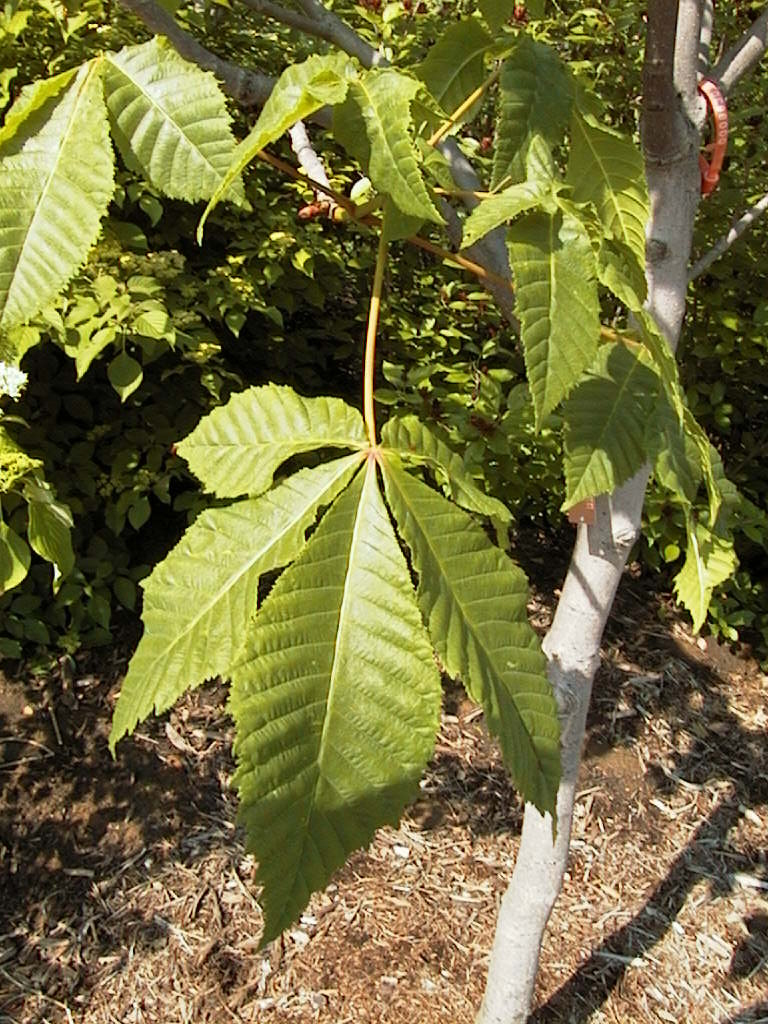Contents:
Common Names | Parts Usually Used | Plant(s) & Culture | Where Found | Medicinal Properties | Biochemical Information
Legends, Myths and Stories | Uses | Formulas or Dosages | Nutrient Content | How Sold | Warning | Resource Links | Bibliography
Scientific Names

- Aesculus hippocastanum L.
- Aesculus Chinensis
- Hippocasanaceae
- Sapindaceae
- Horse Chestnut family
Common Names
- T’ien-shih-li (Chinese name)
Parts Usually Used
Nuts, leaves, flowers, bark
Back to Top
Description of Plant(s) and Culture
Grows to
Back to Top
Where Found
Planted in towns, horsechestnut is naturalized in the United States.
Back to Top
Medicinal Properties
Tonic, stimulant, narcotic, astringent, anti-inflammatory, nutritive, febrifuge, expectorant
Back to Top
Biochemical Information
The seeds contain various saponins including aescine, tannins, flavones, purines, starch, sugar, albumin, and a fatty oil.
The bark contains coumarins, glycoside, resin and pigment.
Back to Top
Legends, Myths and Stories
The name is derived from a famous Taoist priest, Chang
Because of the high tannin content in horse-chestnuts, they must be shelled, crushed and leached overnight in cold water before they can be used. They are then strained and boiled for half an hour. The meal from the nuts is dried and used as medicine for humans or fodder for animals.
The green outer casing of the fruit is poisonous and narcotic but the toxic principles appear to be neutralized by preroasting.
Another chestnut tree (Castanea dentata) is also called horse-chestnut. It is not the horse-chestnut reported on here.
Back to Top
Uses
Recent clinical trials have shown great promise for use of horse chestnut seeds in the treatment of lymphedema of the arms and legs. See the research article links below.
Horse-chestnut leaves have marked narcotic tendencies, and a cupful of standard infusion will ensure deep, calm sleep. It should not, however, be taken too often despite the tonic properties it also enjoys. Essence of horse-chestnut is rich in
Pealed roasted nuts were brewed for diarrhea, prostate ailments. In Europe, preparations of the seeds are believed to prevent thrombosis, rheumatism, neuralgia, burns, thought to help weak veins and arteries. Also used in bronchitis, swollen prostate, gastritis and gastroenteritis. Leaf tea is a tonic; used for fevers, colds, malaria, dysentery; externally, for lupus and skin ulcers. A fluid extract from the fruit protects against sunburn.
A related species: California buckeye (Aesculus californica) was reported to cause abortions in cattle. Although considered poisonous unless fully ripened and properly leached, it was used by the local Native Americans as a remedy for rheumatic aches and toothaches.
Back to Top
Formulas or Dosages
The bark is boiled using
To make external applications: mix
Back to Top
Nutrient Content
Rich in vitamin K
Back to Top
How Sold
Horse chestnut extract can be purchased as supplements, powder and topical cream.
Back to Top
Warning
This herb is potentially fatal. Could cause death or other serious consequences. Although horse-chestnut has been found to be safe and helpful for some people under the guidance and care of trained clinicians, we do not recommend its use for self-diagnosis and treatment.
However, the extract from horse chestnut seeds removes the toxic constituents, making it much safer for medicinal use. Care should be taken to follow instructions exactly.
Horse chestnut should never be used by pregnant or lactating women.
Toxic symptoms include gasteoenteritis, enlarged pupils, drowsiness, and flushing of the skin. Outer husks are poisonous. All parts can be toxic. Fatalities have been reported. Seeds (nuts) contain
Professional care is essential with this herb.
Back to Top
Resource Links
Horse Chestnut: Possible Treatment for Lymphedema
ClinicalTrials.gov: Horse Chestnut Seed Extract for Lymphedema
ScienceDirect: Horse chestnut – efficacy and safety in chronic venous insufficiency: an overview
Back to Top
Bibliography
![]() Eastern/Central Medicinal Plants
Eastern/Central Medicinal Plants, by Steven Foster and James A. Duke., Houghton Mifflin Company, 215 Park Avenue South, New York, NY 10000
![]() Chinese Medicinal Herbs
Chinese Medicinal Herbs, compiled by Shih-Chen Li, Georgetown Press, San Francisco, California, 1973.
 The Magic of Herbs
The Magic of Herbs, by David Conway, published by Jonathan Cape, Thirty Bedford Square, London, England. (Out of print)
![]() American Folk Medicine
American Folk Medicine, by Clarence Meyer, Meyerbooks, publisher, PO Box 427, Glenwood, Illinois 60425, 1973
 Earl Mindell’s Herb Bible
Earl Mindell’s Herb Bible, by Earl Mindell, R.Ph., Ph.D., Simon & Schuster/Fireside, Rockefeller Center 1230 Avenue of the Americas, New York, New York 10020
![]() The Nature Doctor: A Manual of Traditional and Complementary Medicine
The Nature Doctor: A Manual of Traditional and Complementary Medicine, by Dr. H.C.A. Vogel; Keats Publishing, Inc., 27 Pine Street (Box 876) New Canaan, CT. 06840-0876. Copyright Verlag A. Vogel, Teufen (AR) Switzerland 1952, 1991
![]() The Complete Medicinal Herbal
The Complete Medicinal Herbal, by Penelope Ody, Dorling Kindersley, Inc, 232 Madison Avenue, New York, NY 10016, First American Edition, copyright 1993
![]() Webster’s New World Dictionary
Webster’s New World Dictionary, Third College Edition, Victoria Neufeldt, Editor in Chief, New World Dictionaries: A Division of Simon & Schuster, Inc., 15 Columbus Circle, New York, NY 10023
![]() Indian Herbalogy of North America
Indian Herbalogy of North America, by Alma R. Hutchens, Shambala Publications, Inc., Horticultural Hall, 300 Massachusetts Avenue, Boston, Massachusetts 02115, 1973
![]() Planetary Herbology
Planetary Herbology, by Michael Tierra, C.A., N.D., O.M.D., Lotus Press, PO Box 325, Twin Lakes. WI 53181., Copyright 1988, published 1992
